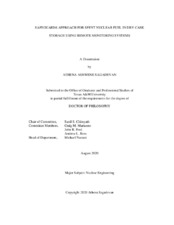| dc.contributor.advisor | Chirayath, Sunil S | |
| dc.creator | Sagadevan, Athena Ashwene | |
| dc.date.accessioned | 2021-02-22T19:07:48Z | |
| dc.date.available | 2022-08-01T06:53:41Z | |
| dc.date.created | 2020-08 | |
| dc.date.issued | 2020-07-08 | |
| dc.date.submitted | August 2020 | |
| dc.identifier.uri | https://hdl.handle.net/1969.1/192595 | |
| dc.description.abstract | Spent fuel pools at nuclear power reactors are reaching their capacity. Since there is no long-term spent nuclear fuel (SNF) storage solution currently, dry cask storage is practiced in the interim. A single dry cask that stores 32 pressurized water reactor SNF assemblies contains about 20 significant quantities (SQ) of special nuclear material (SQ = 8 kg of plutonium). Once the cask is sealed, it is difficult to verify its contents, hence posing a nuclear safeguards concern because of the potential for misuse of plutonium inside the dry cask. In this work, two new remote monitoring systems (RMSs) to detect the diversion of SNF assemblies from dry casks are studied and results are presented. RMS can perform continuous monitoring so that the International Atomic Energy Agency can maintain continuity of knowledge (CoK) and verify the contents of dry casks without opening them.
Simulations of the RMS response to SNF assembly diversions are characterized for various loading patterns with different fuel burnup and cooling times. Multiple SNF assembly diversion scenarios are studied where a diversion includes the removal and substitution of SNF assemblies with dummy fresh fuel assemblies. The Monte Carlo N-Particle (MCNP) transport code is used to model and simulate the RMS design and the dry cask containing SNF assemblies.
The RMS neutron signal estimated from the simulations are analyzed to determine whether CoK of the SNF assemblies in the dry casks can be maintained. The RMS response is calculated for each assembly diversion scenario by setting a false alarm probability (α) and calculating the corresponding non-detection probability (β). For both RMSs, the β probabilities are proved to be less than 20% including a single SNF assembly diversion with a measurement time of less than four minutes. Proof-of-concept experiments are conducted using ²⁵²Cf neutron sources and the β probabilities are calculated for neutron source diversions. Analysis of experimental results concluded that neutron source diversions mimicking the diversion of SNF assemblies are detectable in a short measurement time. Hence, RMS designs developed are accurate and viable as an alternative to in-person inspections to detect SNF assembly diversions. | en |
| dc.format.mimetype | application/pdf | |
| dc.language.iso | en | |
| dc.subject | Safeguards | en |
| dc.subject | spent nuclear fuel | en |
| dc.title | Safeguards Approach for Spent Nuclear Fuel in Dry Cask Storage Using Remote Monitoring Systems | en |
| dc.type | Thesis | en |
| thesis.degree.department | Nuclear Engineering | en |
| thesis.degree.discipline | Nuclear Engineering | en |
| thesis.degree.grantor | Texas A&M University | en |
| thesis.degree.name | Doctor of Philosophy | en |
| thesis.degree.level | Doctoral | en |
| dc.contributor.committeeMember | Marianno, Craig M | |
| dc.contributor.committeeMember | Ford, John R | |
| dc.contributor.committeeMember | Ross, Andrew L | |
| dc.type.material | text | en |
| dc.date.updated | 2021-02-22T19:07:49Z | |
| local.embargo.terms | 2022-08-01 | |
| local.etdauthor.orcid | 0000-0002-1065-5639 | |


